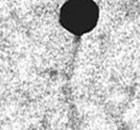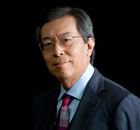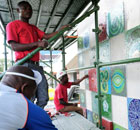
Advancing Excellence in Science Education
In the 23 years that HHMI has provided grants to colleges and universities, it has distributed some $820 million to 264 institutions nationwide. This commitment is noteworthy both for its size and duration, and the grants have sparked measurable advances in everything from student research to curriculum development.
As the grants program matures, however, HHMI is looking for bigger, bolder, and more sustainable approaches. One way to find them is to go beyond simple metrics of success such as counting participants, says David Asai, HHMI’s director of Pre-College and Undergraduate Science Education.
Asai explains, “The emphasis should be on the development of grantees’ students. Counting the number of participants and seeing how many graduate is important because those numbers give a sense of the scale of a program. But the harder and important question is, ‘What have you done in your program so that the students who pass through it are better prepared?’”
The first of several new changes to the grants program will encourage grantees to focus on a single, focused objective. Until recently, grants have been organized around four main components—student research, faculty development, curriculum development, and outreach—referred to by some as “the four food groups.” Although the comparison suggests that all four components are necessary for a balanced program, Asai says the phrasing sometimes led institutions to pursue activities for the sake of doing them.
“Instead, we want to encourage schools to identify an overarching objective and choose whatever blend of strategies they need to meet the needs of their school,” he says. “We think this approach will sharpen that focus.”
A second change will push schools to consider joint projects in which two or three invited schools will form a partnership. As science becomes increasingly interdisciplinary and complex, schools often don’t have all of the required expertise or equipment to tackle ambitious projects. Joint programs should allow schools to work together to leverage their individual strengths, Asai explains.
“By creating a partnership, they could do much more than they could individually. We hope that the partnership results in a program that is greater than the sum of its individual parts,” he says.
The final change will apply some modest cost-sharing requirements to schools that have been most successful in securing grants. Schools that have received four, five, or six grants in the six completed grant cycles will be expected to pay for between 4 and 12 percent of the grant total. This approach encourages longstanding grantees to evaluate their progress, identify their best programs, and develop mechanisms to sustain and expand programs so that they are more fully integrated into the institution.
In a parallel effort to support the most innovative programs in science education, HHMI this year also made a substantial investment in two national initiatives.
One is a significantly expanded Summer Institute, a program that helps biology faculty members improve their effectiveness by applying scientific teaching techniques. During the past seven years, more than 300 science faculty from research institutions have benefited from the Madison, Wisconsin-based program, and over the next five years, eight new regional centers will be added.
Sean B. Carroll, HHMI’s vice president for science education, says it was time to increase the program’s reach. “We hope to greatly expand the number of faculty members who participate and bring what they learn back to their campuses,” he says, noting that the new sites will be able to reach thousands of faculty members from a wide variety of institutions.
The second project is the newly developed National Experiment in Undergraduate Science Education (NEXUS), a four-year project that brings four universities together to develop effective approaches to implement the interdisciplinary competencies identified in the Scientific Foundations for Future Physicians report (Association of American Medical Colleges-HHMI, 2009).
The NEXUS program will focus on developing a curriculum and appropriate assessment tools; the expected result will be innovative modules that can be dropped into existing courses, or even used as a foundation for an entire curriculum overhaul.
Philip Rous, former chair of the NEXUS steering committee and physics professor at the University of Maryland, Baltimore County, says the program is ambitious. “If you can test [these new ideas] at different types of schools across the country, then you have the potential for a national impact,” he says.
The grants program will remain the heart of HHMI’s science education work, but the changes to it and the Summer Institute, along with the addition of NEXUS, are designed to make a successful endeavor even more effective, says Asai.
“We really want to encourage the faculty at some of the best schools in the country to think hard about what they’re doing for students’ development while students are there,” he says. “The program has matured to the point where we can start asking these questions.”



